Chicken lo mein is a delicious Chinese stir fry with chewy lo mein noodles, chicken bites, and tender veggies cooked in a sweet and savory sauce. Make this flavorful takeout recipe at home in 30 minutes!
I love recreating authentic takeout dishes in my kitchen! From Chinese chicken and broccoli to homemade General Tso’s chicken, a quick stir-fry is the perfect weeknight dinner.
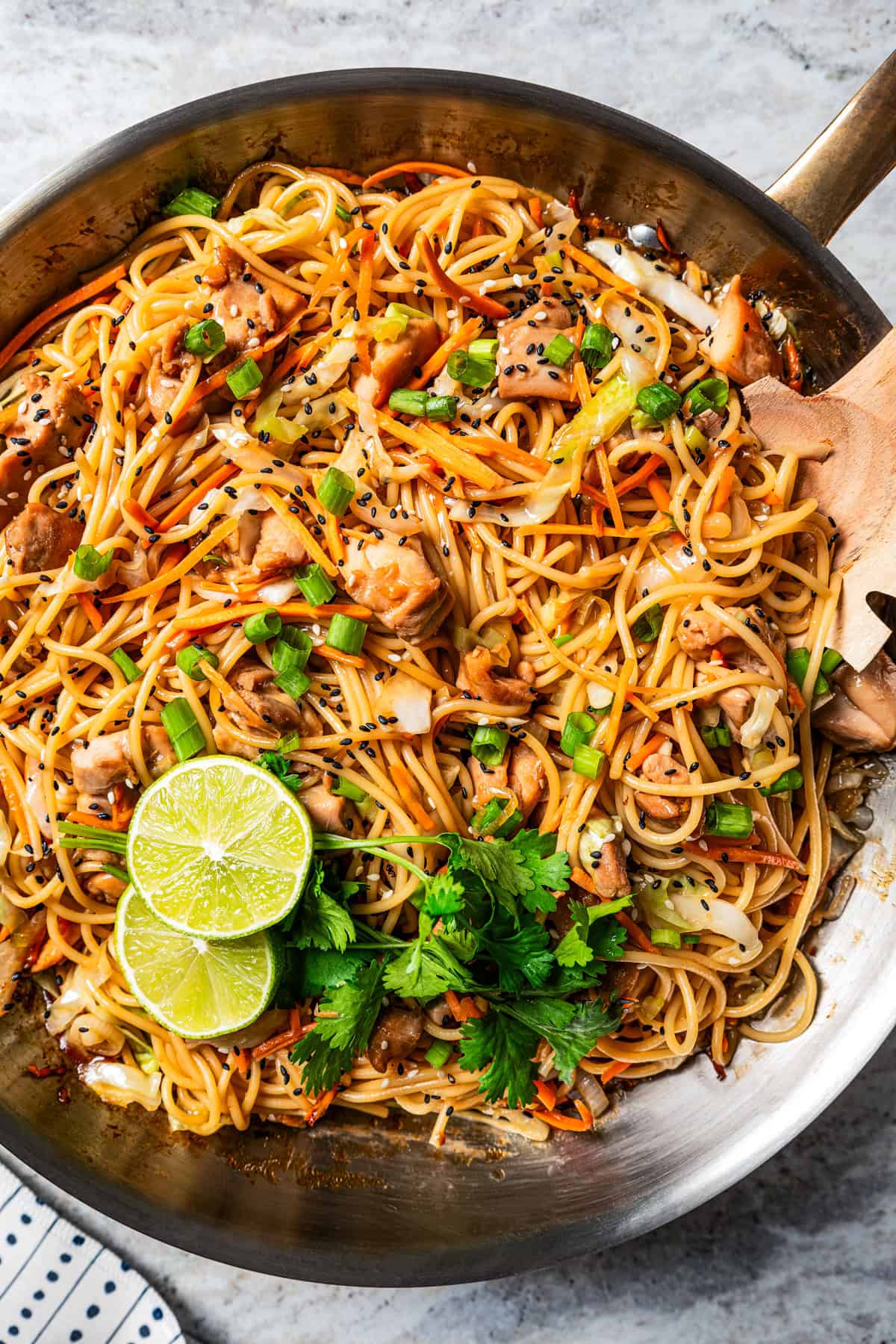
This chicken lo mein uses easy ingredients and it’s packed with all the rich and saucy umami flavors that I crave from our local Chinese takeout joint. All it takes is a few Asian pantry staples like soy sauce, oyster sauce, and sesame oil to give my homemade lo mein its authentic flavor! Meanwhile, juicy marinated chicken, chewy egg noodles, and tender veggies make this chicken lo mein an all-in-one meal that the whole family obsesses over. It’s one of those dinners that never fails to make everyone happy, and it’s often requested for quick weeknight dinners.
Why I Love Homemade Chicken Lo Mein
- Just like the real deal. Homemade Chinese takeout has become a bit of a hobby. My goal is always to get as close to the real dish as possible. I won’t lie, with its savory sauce, this chicken lo mein turned out pretty darn close and maybe even better than what I order from restaurants!
- It’s quick. Once I realized how simple and quick it is to remake some of my favorite takeout noodle dishes at home, there was no going back. I love recipes like chicken lo mein and chicken ramen noodles, that I can have on the table in about 30 minutes on weeknights.
- Adaptable. Making homemade chicken lo mein means that I can adapt the recipe exactly how I like it, with more or less sauce, extra veggies, different protein, etc. I include easy variations and ingredient swaps further down in the post.
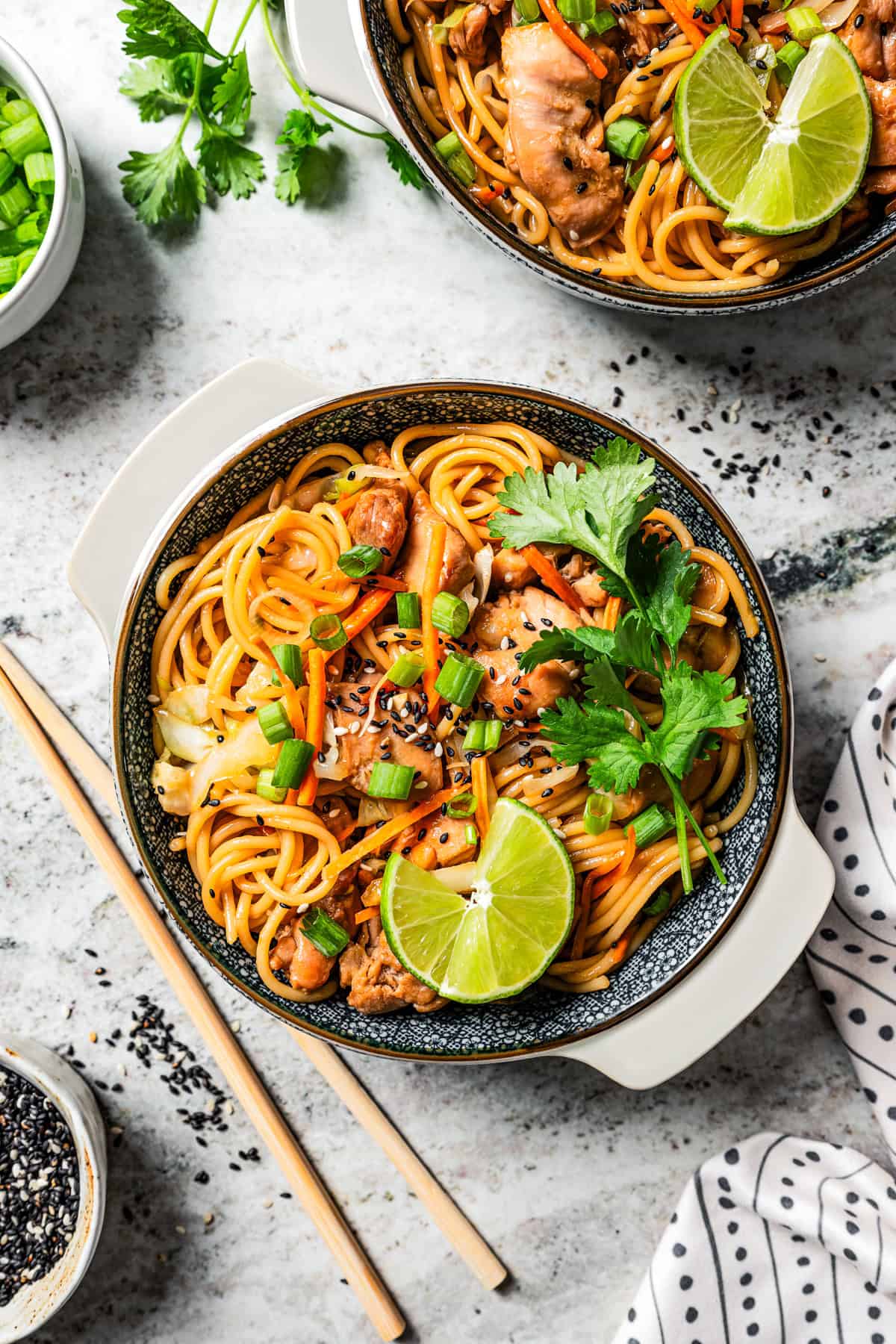
What’s the Difference Between Lo Mein and Chow Mein?
If you’ve ever eaten at a Chinese restaurant, you’ve probably seen both on the menu! Both lo mein and chow mein are delicious egg noodle dishes, but the biggest difference is how the noodles are prepared. Chow mein is “fried” together with the protein and veggies, while lo mein noodles get cooked separately before they’re “tossed” in sauce with the rest of the ingredients. As a result, lo mein recipes are a bit saucier, while chow mein tends to be drier.
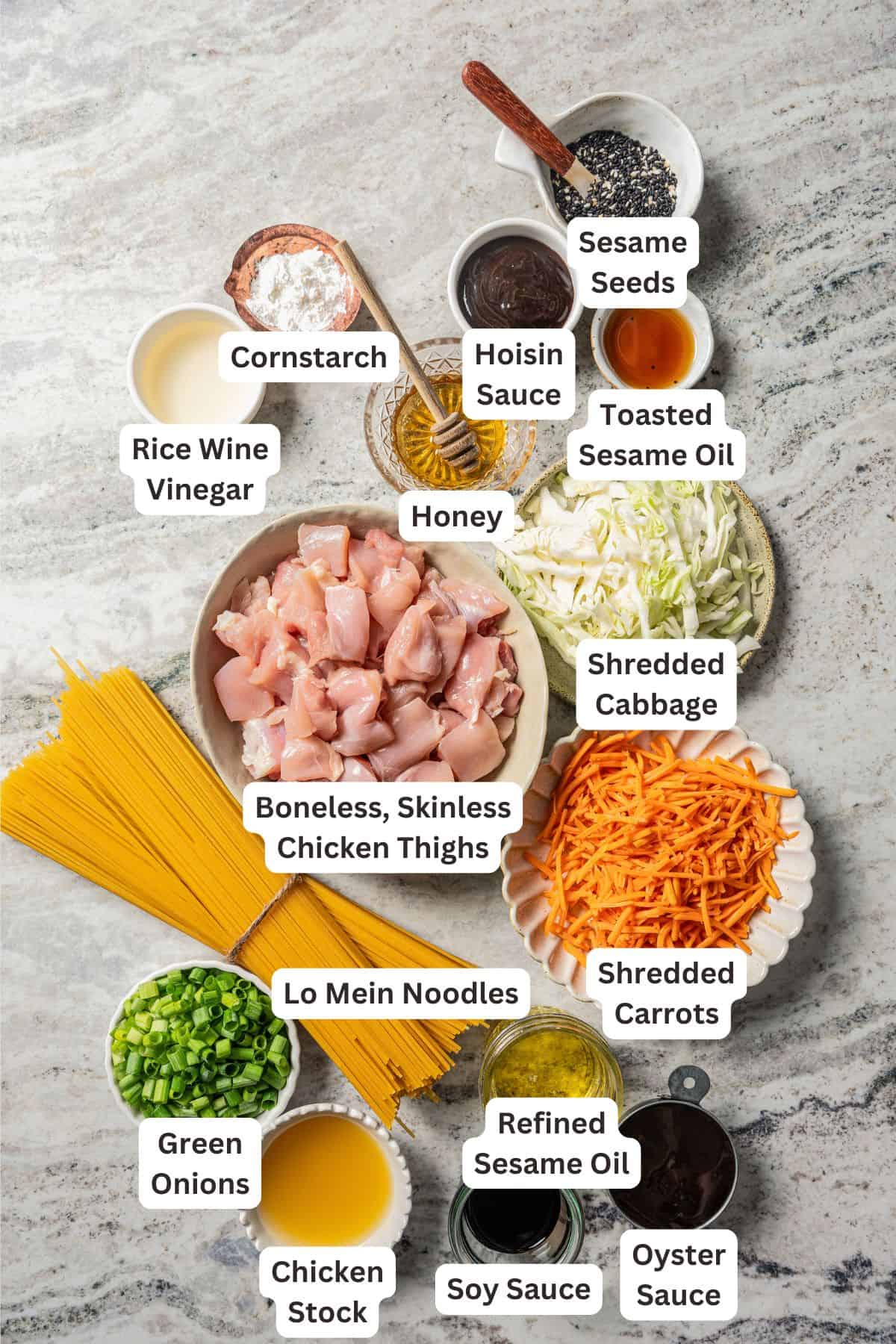
What You’ll Need
This chicken lo mein recipe uses a few essential Asian pantry staples. Below are some quick notes on the stir fry ingredients, but for the full recipe details, please scroll to the recipe card after the post for a printable list.
- Chicken – I like to use boneless skinless chicken thighs. You can use chicken breasts, though they’re easier to overcook. Chop the chicken into 1” pieces.
- Soy Sauce – You can also use tamari or coconut aminos.
- Noodles – You’ll find authentic lo mein in international food aisles and Asian supermarkets. Otherwise, spaghetti makes a good substitute for lo mein noodles.
- Sesame Oil – There’s really no substitute for sesame oil in Asian-style cooking. Do your best to get your hands on some! It can be refined or toasted sesame oil.
- Vegetables – I use a combination of shredded carrots and cabbage. Feel free to swap in other fresh (or frozen) veggies like broccoli florets, bell peppers, cauliflower, etc.
- Green Onions – Slice them up and divide the whites from the greens. The greens make a pretty garnish along with sesame seeds.
Lo Mein Sauce Ingredients
- Oyster Sauce and Hoisin Sauce – Along with additional soy sauce, oyster and hoisin sauce create the umami base for this noodle dish. You’ll find both in the condiment aisle. If needed, you can substitute dark soy sauce for hoisin sauce.
- Honey – You could also use maple syrup or brown sugar.
- Sesame Oil – I use a combination of refined and toasted sesame oil in the sauce. Use whichever you have on hand (it can be the same oil you used to cook the chicken).
- Rice Wine Vinegar – Good substitutes are Asian cooking wines like mirin or sake, white wine or red wine vinegar, dry sherry, or dry white wine.
- Garlic – Freshly minced. In a pinch, swap ¼ teaspoon of garlic powder for every fresh clove.
- Chicken Stock – You could also use vegetable stock.
- Cornstarch – Cornstarch thickens the lo mein sauce and makes it silky. Tapioca starch or arrowroot powder will work, too.
How to Make Chicken Lo Mein
I like to marinate the chicken in soy sauce first. IMO, it’s worth the extra 10 minutes for the extra flavor it brings to the stir-fry! I’ll usually cook the noodles and whisk up the sauce in the meantime.
Of course, feel free to skip the marinading if you’re short on time. For now, here’s a visual step-by-step showing how to make the best homemade chicken lo mein:
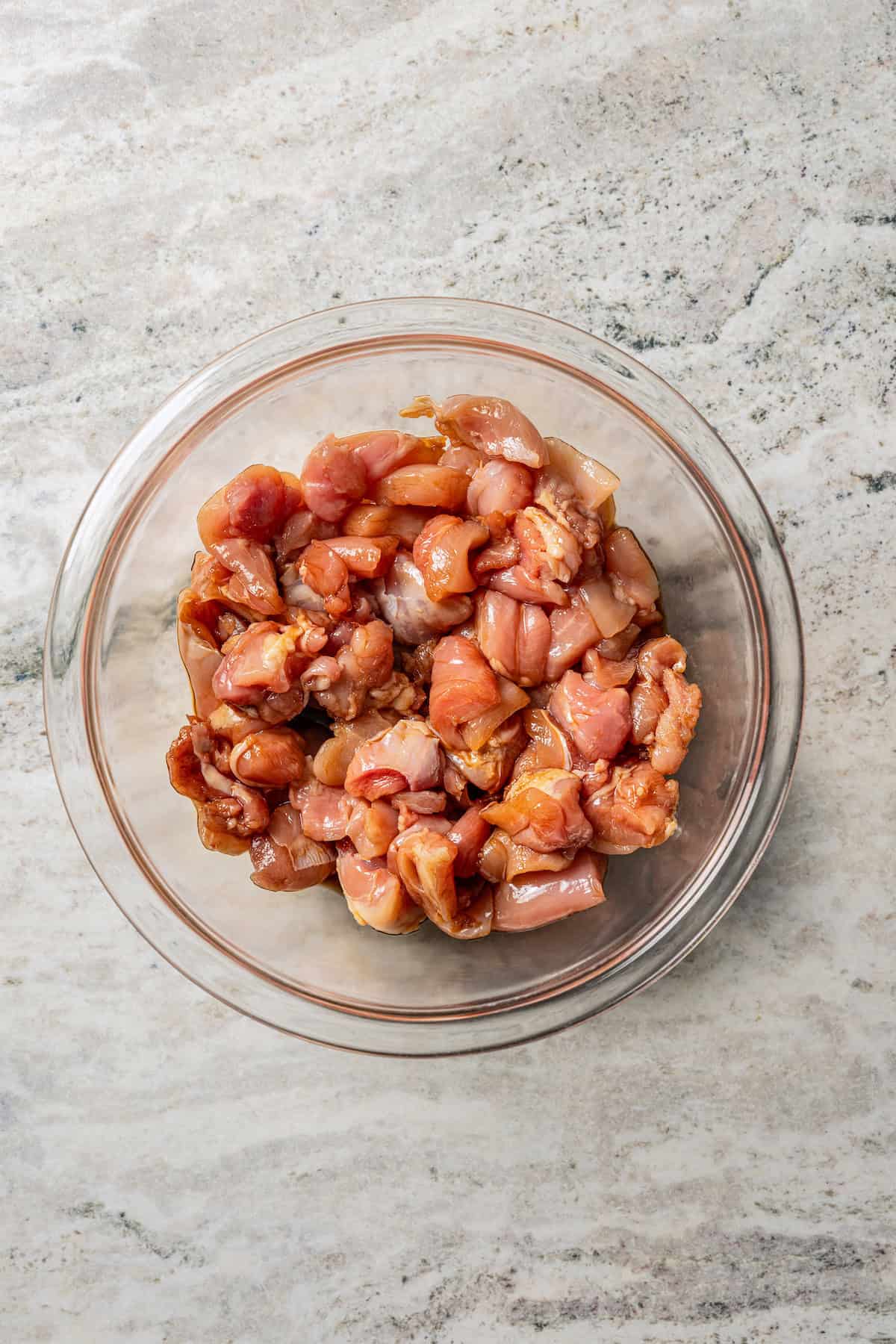
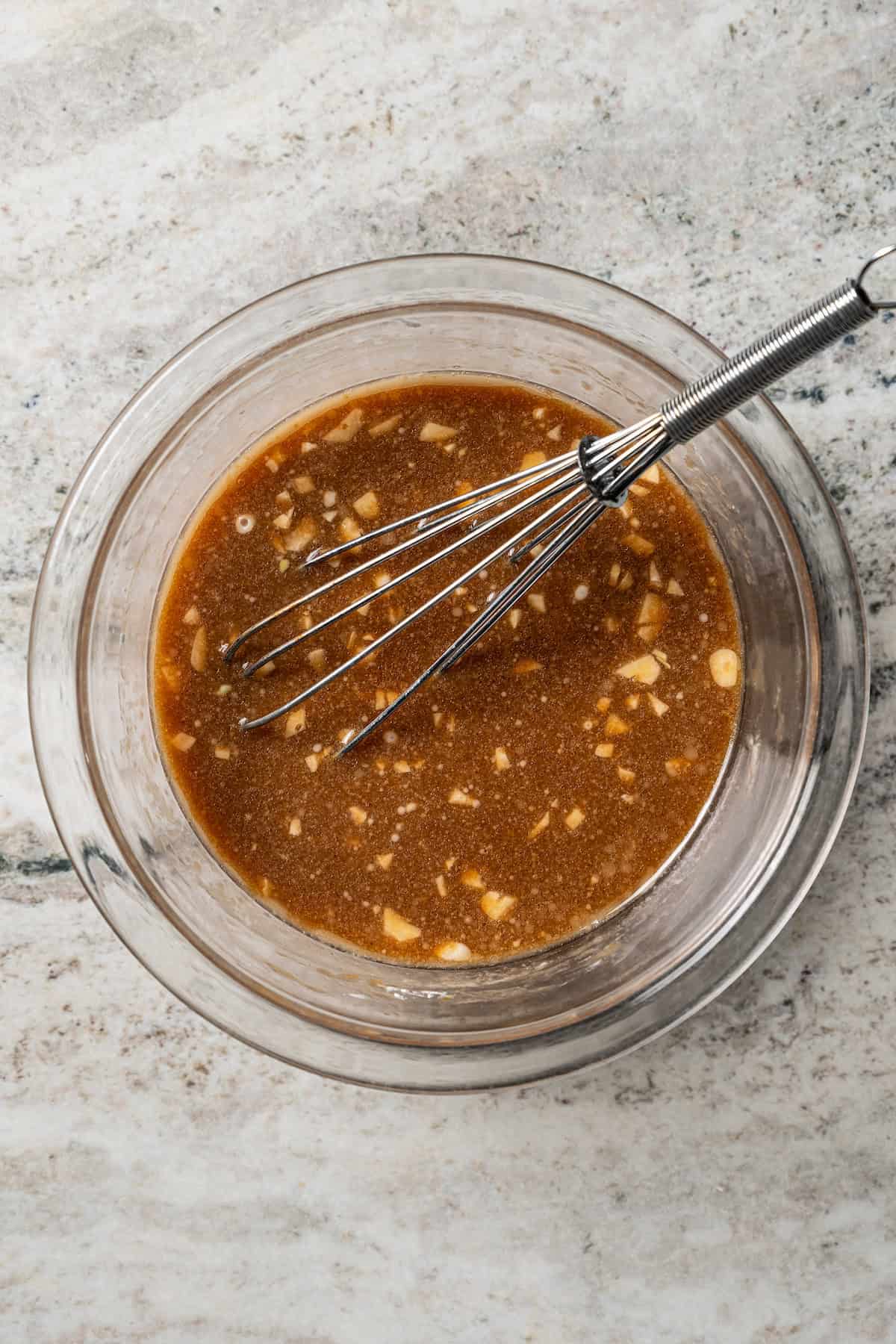
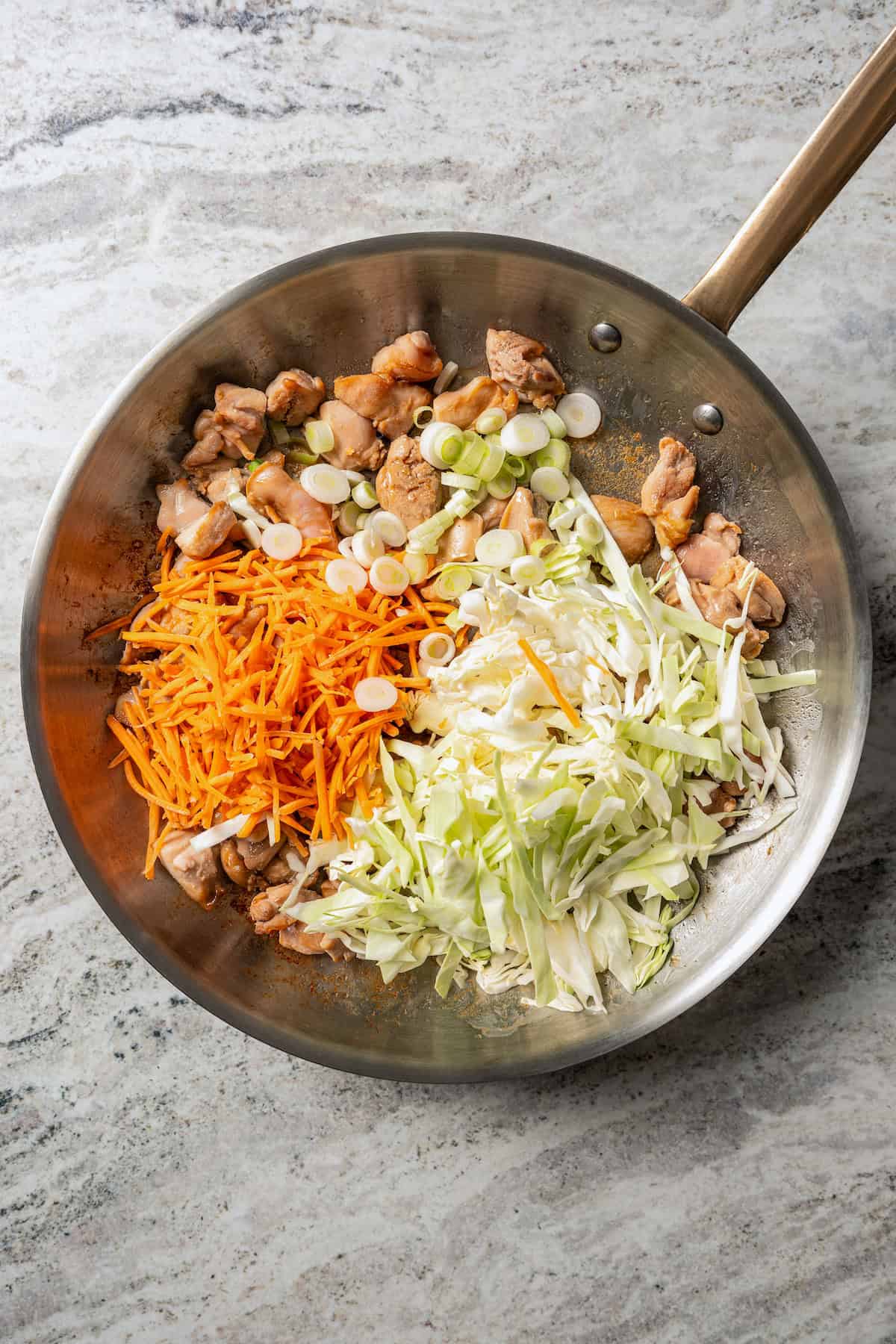
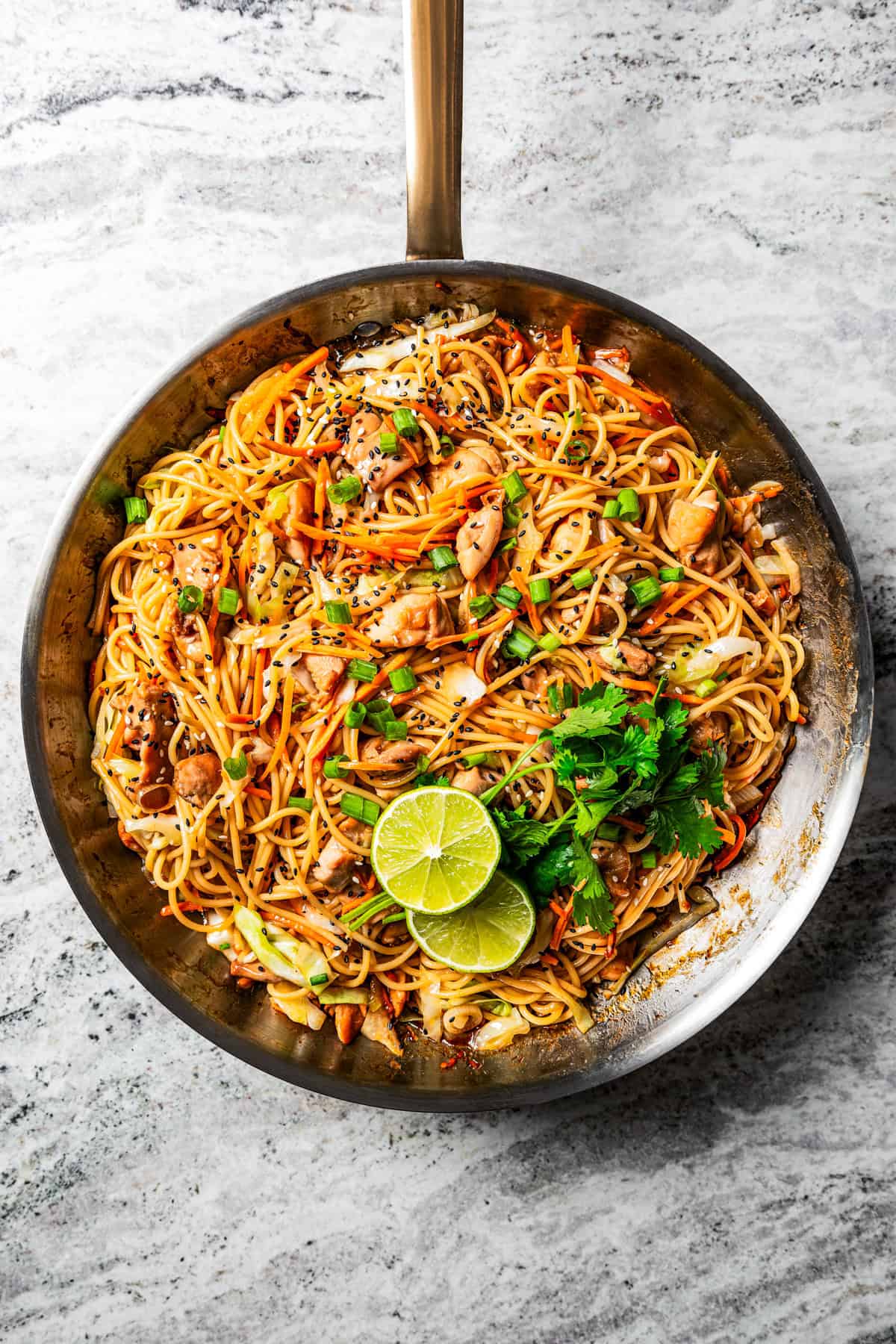
- Marinate the chicken. Start by tossing the chicken pieces with soy sauce and letting that marinate while you make the sauce.
- Mix up the sauce. Take out a bowl and whisk together the lo mein sauce ingredients.
- Cook the noodles. Meanwhile, boil the noodles in salted water according to the package directions.
- Sauté the chicken and veggies. Next, brown the marinated chicken pieces in a skillet with sesame oil over medium-high heat. Once that’s almost cooked through, stir in the cabbage and carrots. Sprinkle in the whites of the onions and sauté until the veggies are softened.
- Put it all together. Add your cooked noodles to the skillet and pour over the prepared sauce. Give everything a good toss to coat, then serve! Garnish your chicken lo mein with sesame seeds and the leftover greens from the onions. See below for more serving ideas.
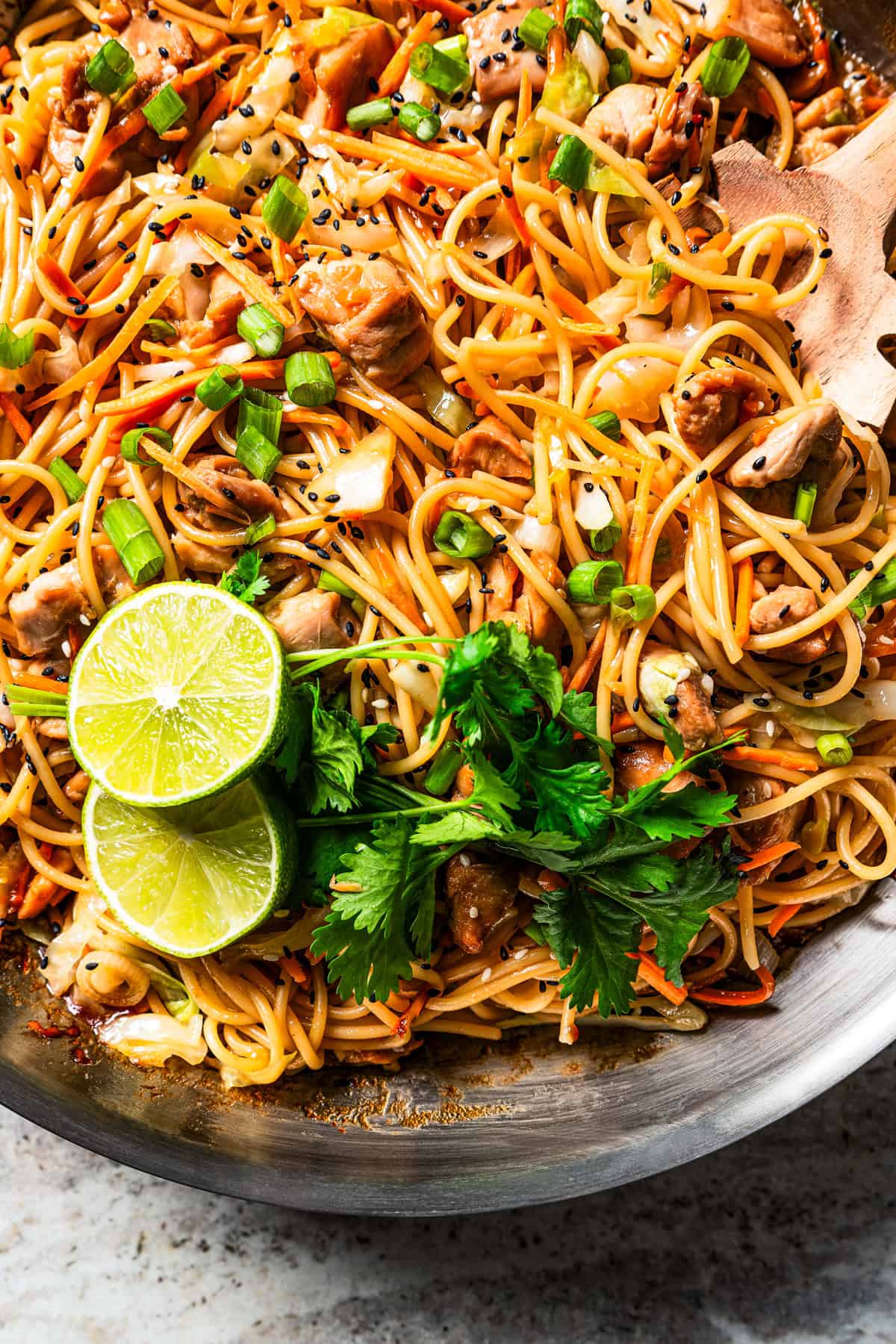
Tips and Variations
- Don’t overcook the noodles. Since you’ll be adding the noodles back into the pan to finish off this chicken lo mein, be careful to not overcook them. Just like when cooking pasta, aim for al dente or slightly under. This way, they won’t become overcooked and mushy.
- Salt the water. Again, like when you cook pasta, remember to add a spoonful of salt to the water you’ll use to boil your egg noodles. This handy trick seasons the noodles, even before they’re combined with the lo mein sauce.
- Be gentle. Once you’ve added the noodles to the pan with the rest of your chicken lo mein ingredients, stir gently while you coat them in the sauce so the noodles don’t break.
- Try a different protein. It’s possible to swap out the chicken pieces for another protein of your choice. Try beef or shrimp lo mein. You can also substitute the meat for tofu as a vegetarian option.
- More veggies. I mentioned it in the Ingredients section, but plenty of veggies work well here. Along with cabbage and carrots, good stir-frying vegetables are sliced bell peppers, mushrooms, broccoli or cauliflower florets, or other add-ins like bean sprouts, watercress, and bamboo shoots. Frozen veggies are a great way to cut down on prep, too.
- Low carb. Swap the noodles for fresh zoodles (zucchini noodles) for a low-carb version. There’s no need to cook zucchini noodles first, you can stir them in right at the end and let them cook through in the sauce.
Frequently Asked Questions
The term “mein” is the Chinese word for noodles. So, lo mein translates to “tossed noodles”, while chow mein means “stir-fried noodles”.
Traditional lo mein recipes use thick, fresh egg noodles. Chow mein, on the other hand, uses thinner noodles (perfect for stir-frying) that can be fresh or dry.
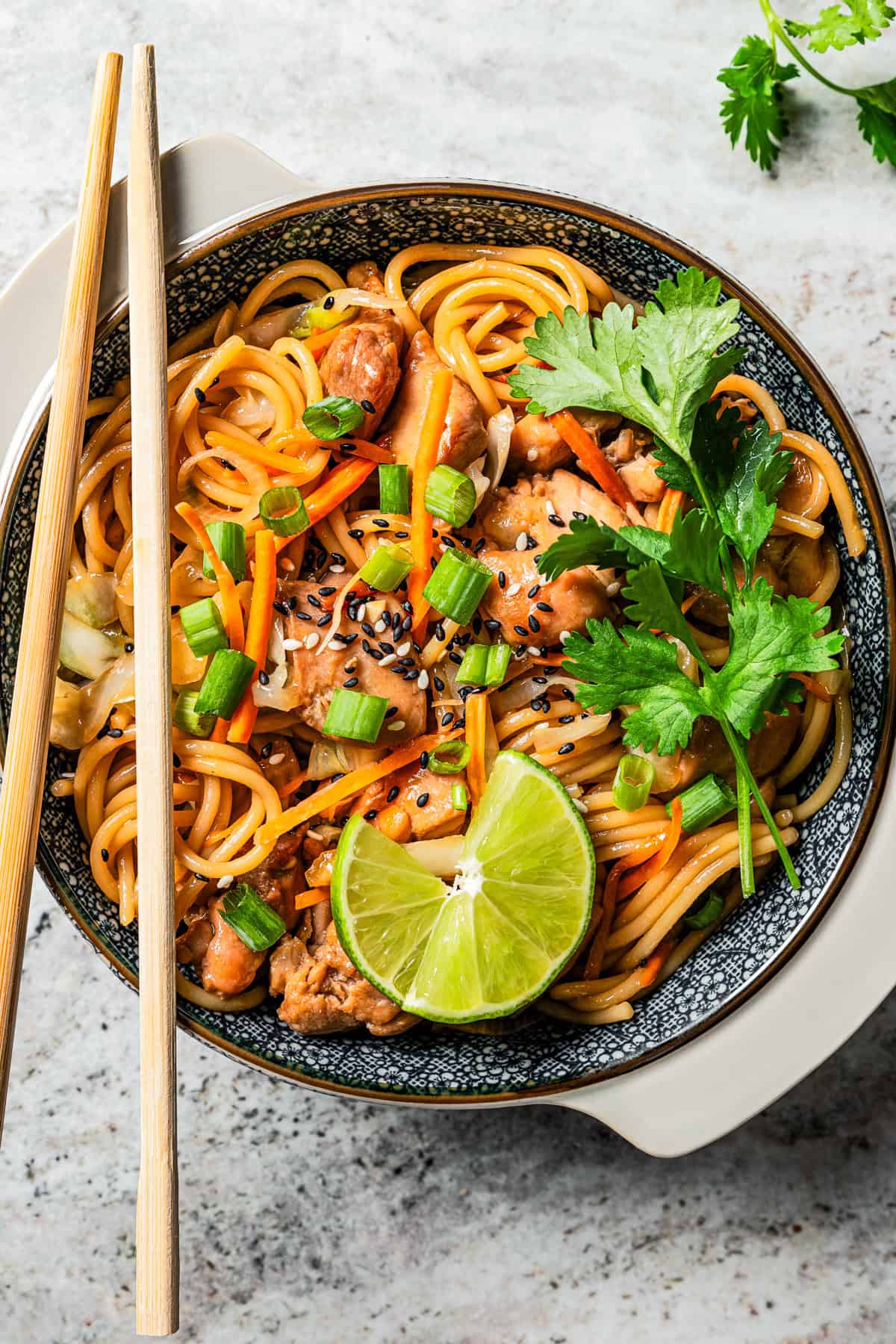
Serving Suggestions
Chicken lo mein goes great with Chinese boneless spare ribs and shrimp fried rice. I also love kicking things off with an appetizer, like spring rolls or crab rangoon in the air fryer!
For some refreshing crunch, try an Asian cucumber salad on the side. Other good veggie choices are garlicky sautéed broccolini and pan-fried oyster mushrooms.
Storing and Reheating Leftovers
- Refrigerate. Store cooled leftover chicken lo mein airtight in the fridge for up to 3 days. If you keep the stir-fried chicken and veggies separate, the noodles will last airtight for up to 5 days.
- Reheat. I like to warm my chicken lo mein in a skillet over medium heat, or I’ll use the microwave. Stir gently and be careful not to overcook the noodles while reheating.
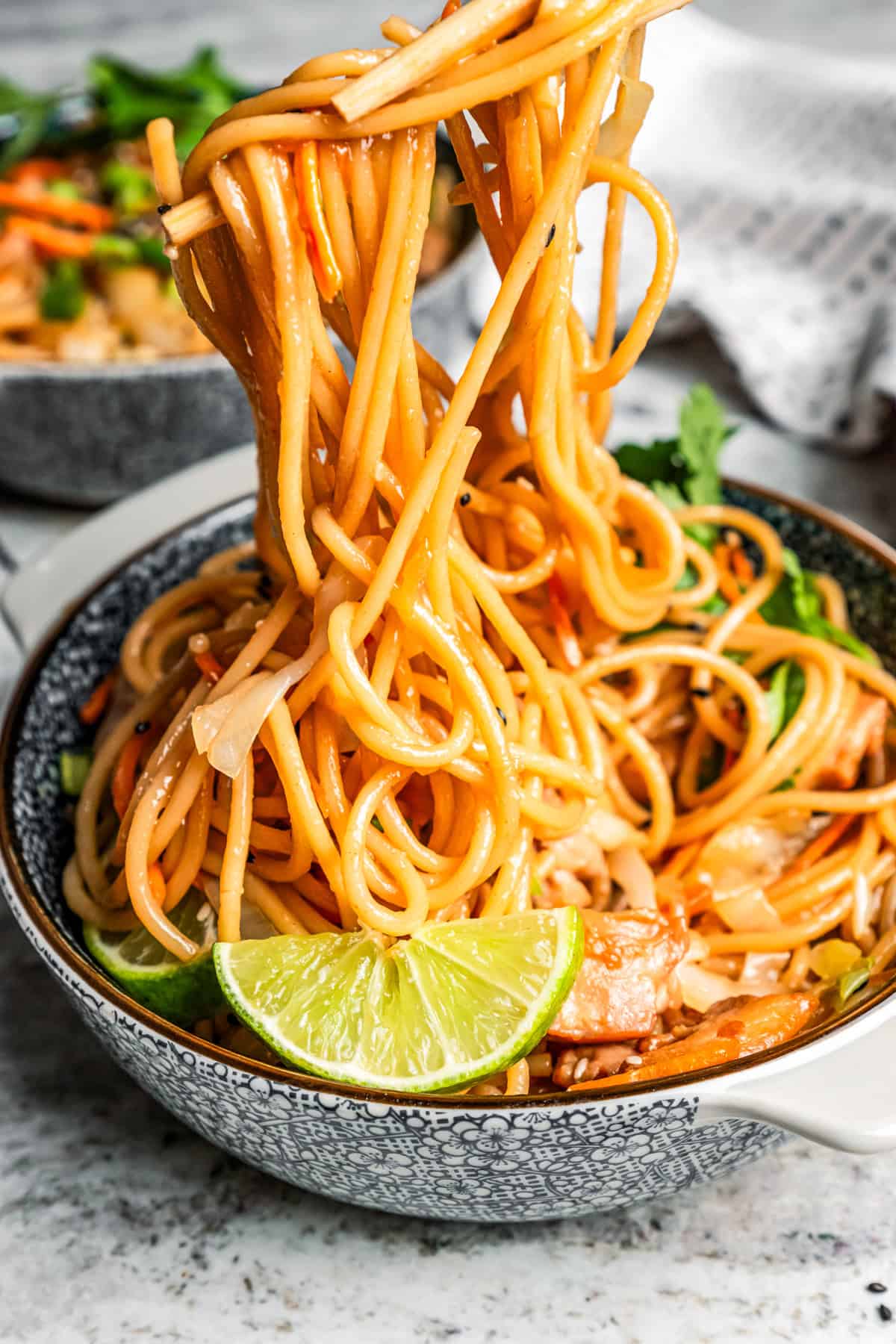
More Asian-Inspired Recipes
Pin this now to find it later
-
Marinade the chicken. In a medium-sized mixing bowl, toss the chicken with soy sauce. Let the chicken marinade for ~15 minutes. Make the sauce in the meantime.
-
Make the sauce. In a separate mixing bowl, combine the oyster sauce, hoisin, soy sauce, honey, refined sesame oil, toasted sesame oil, rice wine vinegar, garlic, chicken stock, and cornstarch. Whisk until smooth and set aside.
-
Make the noodles. Bring a large pot of water to a boil and add the salt. Add the noodles and cook per the package’s instructions. Drain and set aside.
-
Brown the chicken. While the noodles are cooking, heat the refined sesame oil over medium-high heat in a wok or a large, heavy-bottomed skillet. Add the chicken (discard the soy sauce it was marinating in) and saute until golden brown and almost cooked through.
-
Saute the veggies. Add the cabbage, carrots, and the whites of the green onions to the wok. Saute until slightly wilted. The chicken should be cooked through at this point.
-
Put it all together. Stir the cooked noodles into the chicken mixture along with the oyster-sauce mixture. Saute until the sauce has thickened and the noodles are thoroughly coated in it.
-
Serve. Serve warm, garnished with sesame seeds and the greens of the green onions.
Calories: 596kcal | Carbohydrates: 68g | Protein: 32g | Fat: 22g | Saturated Fat: 3g | Polyunsaturated Fat: 7g | Monounsaturated Fat: 8g | Trans Fat: 0.02g | Cholesterol: 109mg | Sodium: 2125mg | Potassium: 434mg | Fiber: 3g | Sugar: 6g | Vitamin A: 1610IU | Vitamin C: 7mg | Calcium: 37mg | Iron: 2mg
Nutritional info is an estimate and provided as courtesy. Values may vary according to the ingredients and tools used. Please use your preferred nutritional calculator for more detailed info.


